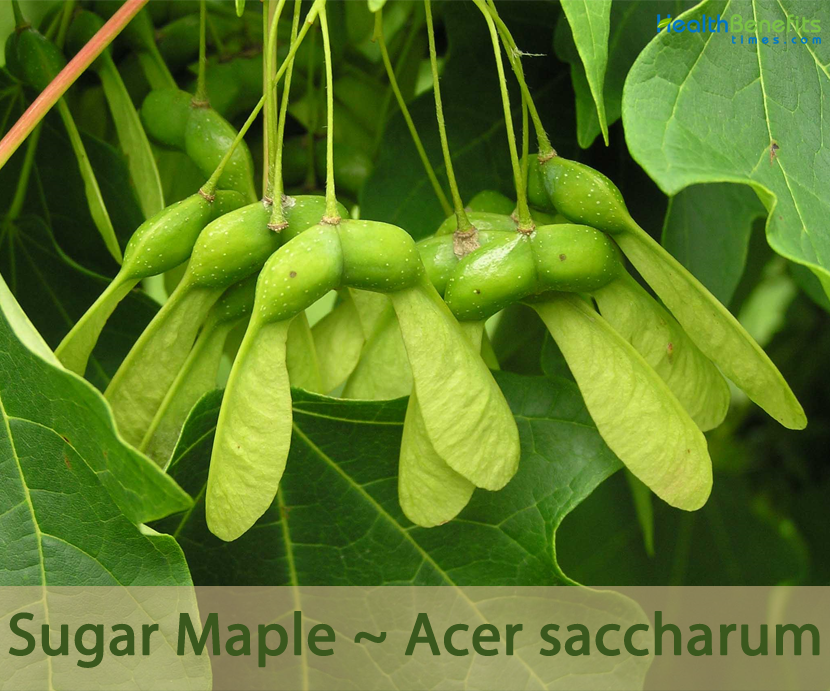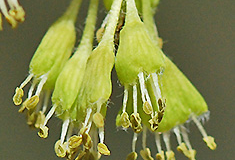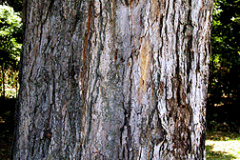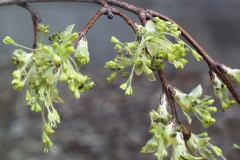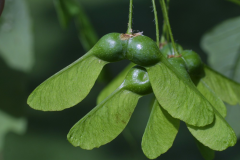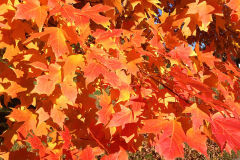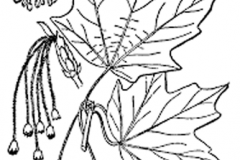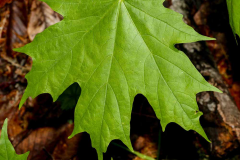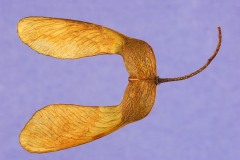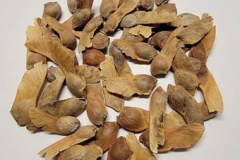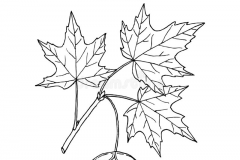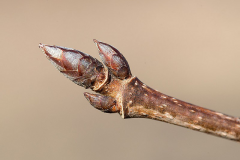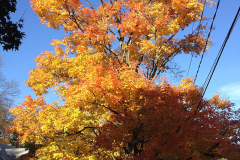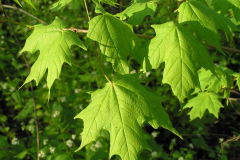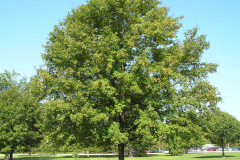| Sugar Maple Quick Facts | |
|---|---|
| Name: | Sugar Maple |
| Scientific Name: | Acer saccharum |
| Origin | Nova Scotia and New Brunswick westward to Ontario and Manitoba, southward through Minnesota, and eastern Kansas into northeastern Texas |
| Colors | Green, turning red to red-brown as they mature |
| Shapes | Pair of one-seeded samaras (winged seeds) each about 1 inch long, with a broad wing that is paired at the top forming an angle of 60 to 90 degrees |
| Health benefits | Support coughs, diarrhea, blindness, sore eyes, liver tonic and kidney cleanser |
| Name | Sugar Maple |
|---|---|
| Scientific Name | Acer saccharum |
| Native | Grows from Nova Scotia and New Brunswick westward to Ontario and Manitoba, southward through Minnesota, and eastern Kansas into northeastern Texas. It extends eastward to Georgia and northward through the Appalachian Mountains into New England |
| Common Names | Sugar Maple, Florida Maple, Hard Maple, Rock Maple, head maple, sugar tree, bird’s-eye maple |
| Name in Other Languages | Afrikaans: Suiker maple, Maselhout Albanian: Panje sheqeri, panjë Amharic: Yesikwari mapi (የስኳር ማፕ) Arabic: Alqayqib alsukar (القيقب السكر), qiqab sukari (قيقب سكري) Armenian: Shak’aravaz t’khku (շաքարավազ թխկու), T’khki artsat’ap’ayl (Թխկի արծաթափայլ) Azerbaijani: Səkər ağcaqayın Bengali: Cinira myāpēla (চিনির ম্যাপেল) Bulgarian: Zakharen klen (захарен клен), zakharen yavor (захарен явор) Burmese: S kyarr may paal (သကြားမေပယ်) Catalan: Auró del sucre Chinese: Fēng tang (枫糖), táng fēng (糖枫) Croatian: Sećerni javor Czech: Cukr javor, Javor cukrový, Javor cukrodárný Danish: Sukker ahorn, Sukkerløn Dutch: Suikeresdoorn, suikerahorn English: Sugar maple, Hard maple, Rock maple, Birds’ eye maple, black sugar maple, rocki maple Esperanto: Sukero arce Estonian: Suhkru vaher Filipino: Maple ng asukal Finnish: Sokerivaahtera, Sokerivaahter French: Erable à sucre, Érable franc, Érable franche Galician: Pradairo azucreiro Georgian: Shakris nek’erchkhali (შაქრის ნეკერჩხალი) German: Zucker-Ahorn, Zuckerahorn, Echter Zuckerahorn, Vogelaugenahorn Greek: Sfendámi zácharis (σφενδάμι ζάχαρης), sakcharódis sféndamos (σακχαρώδης σφένδαμος) Gujarati: Sugara mēpala (સુગર મેપલ) Hausa: Sugar sugar Hebrew: Eder hasukar, מייפל סוכר Hindi: Shugar mepal (शुगर मेपल) Hungarian: Cukor juhar Icelandic: Sykurhlynur Indonesian: Maple gula Irish: Maple siúcra Italian: Acero di zucchero, Acero da zucchero, acero zuccherino Japanese: Satoukaede (サトウカエデ) Javanese: Maple gula Kannada: Sakkare mēpal (ಸಕ್ಕರೆ ಮೇಪಲ್) Kashubian: Cëkrzany klón Kazakh: Qant üyeñki (қант үйеңкі) Korean: Seoltang meipeul (설탕 메이플), seol tang dan pung (설탕단풍) Kurdish: Nexşeya şekir Lao: Maple oatan (maple ້ໍາຕານ) Latin: Sugar maple Latvian: Cukura kļava, Cukura kļava Lithuanian: Cukraus klevo, Cukrinis klevas Macedonian: Seḱer javor (шеќер јавор) Malagasy: Maple siramamy Malay: Gula maple Malayalam: Pañcasāra mēppiḷ (പഞ്ചസാര മേപ്പിൾ) Maltese: Aġġru taz-zokkor Marathi: Sākhara mĕpala (साखर मॅपल) Miꞌkmaq: Snawey Mongolian: Chikhriin agch (чихрийн агч) Nepali: Cinī myāpala (चिनी म्यापल) Norwegian: Sukker lønn Oriya: ଚିନି ମ୍ୟାପଲ୍ | Pashto: بوره Persian: افرا شکر Polish: Klon cukrowy Portuguese: Bordo de açúcar, Bordo-açucareiro, ácer-açucareiro Punjabi: Khaḍa maipala (ਖੰਡ ਮੈਪਲ) Romanian: Zahar de artar, Paltin de zahăr Russian: Klenovyy sakhar (кленовый сахар), Klen sakharnyj (Клен сахарный), klon kanadskiy (клён канадский), klion sacharistyj (клён сахаристый) Serbian: Sećerni javor (шећерни јавор) Sindhi: شوگر ميپل Sinhala: Sīni mēpal (සීනි මේපල්) Slovenian: Sladkorni javor Spanish: Arce de azúcar, Sladkorni javor , arce sacarino Sudanese: Gula maple Swedish: Sockerlönn, svartlönn Tajik: Xordor şakar (хордор шакар) Tamil: Carkkarai mēppiḷ (சர்க்கரை மேப்பிள்) Telugu: Cakkera māpul (చక్కెర మాపుల్) Thai: N̂ảtāl thrāy dæng (น้ำตาลทรายแดง) Turkish: Akçaağaç şekeri, Gümüşiakçaağaç, Şeker akçaağacı Ukrainian: Tsukrovyy klen (цукровий клен), Klen tsukrovyy (Клен цукровий) Urdu: شوگر میپل Uzbek: Shakar zarang Vietnamese: Cây mía, Phong đường Welsh: Masarn siwgr Zulu: Imephu yeshukela |
| Plant Growth Habit | Large, slow-growing, deciduous tree |
| Growing Climates | Hilly woods, rich, mesic woods, drier upland woods, stream terraces, stream banks, valleys, canyons, ravines, and wooded natural levees, margins of glades, ledges and bases of bluffs, sandy woodlands, north-facing wooded slopes, limestone glades |
| Soil | Can grow on a wide variety of soils, but typically grows best on deep, moist, fertile, well-drained soils. It grows on sand, loamy sand, sandy loam, silty loam, and loam. Sugar maple is commonly associated with alluvial or calcareous soils but also grows on stabilized dunes. This tree is intolerant of flooded soils and generally grows poorly on dry, shallow soils |
| Plant Size | 90 to 120 feet (27-37 m) in height and 30 to 36 inches (76-91 cm) in diameter. Extremely large specimens have reached more than 130 feet (40 m) in height and more than 5 feet (1.5 m) in diameter |
| Root | Relatively deep-rooted, with many extensively-branched laterals |
| Bark | Variable, brownish on younger trees and light gray to dark gray on old trunks becoming rough and deeply furrowed into narrow scaly ridges that have flat irregular surfaces |
| Twigs | Twigs are slender, shiny, and brown to reddish-brown, with lighter lenticels while new |
| Leaf | Leaves are simple, deciduous and opposite, the blade up to 6 inches long and 7 inches wide with 5 palmate lobes, the upper 3 are large and squarish below the pointed tips and the two basal lobes are much reduced or nearly lacking. Sugar Maple leaves turn red, yellow, or orange in autumn |
| Flowering season | April to May |
| Flower | The flowers are unisexual. The tree can be monoecious with both male and female flowers or can be dioecious, with the flowers separated by sex on different trees. Male flowers (staminate) are in drooping umbels (tassel-like clusters) up to 3 to 4 inches long, on hairy stalks. The female flowers (pistillate) are also in drooping clusters, but shorter, 1 to 2 inches long. They are the same size and color as the male flowers but with a 2-carpel ovary and a divided style. |
| Fruit Shape & Size | Pair of one-seeded samaras (winged seeds) each about 1 inch long, with a broad wing that is paired at the top forming an angle of 60 to 90 degrees |
| Fruit Color | Green, turning red to red-brown |
| Seed | Globose, 7–10 mm (9⁄32–13⁄32 in) in diameter, the wing is 2–3 cm (3⁄4–1+1⁄4 in) long |
| Propagation | By seed or vegetatively by budding, grafting, air-layering, or by rooting stem cuttings |
| Season | August–October |
| Lifespan | 200-300 years |
Plant Description
Sugar Maple is a large, slow-growing, deciduous hard-wooded tree that normally grows about 90 to 120 feet (27-37 m) in height and 30 to 36 inches (76-91 cm) in diameter. Extremely large specimens have reached more than 130 feet (40 m) in height and more than 5 feet (1.5 m) in diameter. Sugar maple is long-lived and plants can survive for 300 to 400 years. A 10-year-old tree is typically about 5 m (20 ft.) tall. As with most trees, forest-grown sugar maples form a much taller trunk and narrower canopy than open-growth ones. The plant is found growing in hilly woods, rich, mesic woods, drier upland woods, stream terraces, stream banks, valleys, canyons, ravines, wooded natural levees, margins of glades, ledges and bases of bluffs, sandy woodlands, north-facing wooded slopes and limestone glades.
The plant can grow on a wide variety of soils, but typically grows best on deep, moist, fertile, well-drained soils. It grows on sand, loamy sand, sandy loam, silty loam, and loam. Sugar maple is commonly associated with alluvial or calcareous soils but also grows on stabilized dunes. This tree is intolerant of flooded soils and generally grows poorly on dry, shallow soils. Sugar maple grows about one foot each year in most soils but is sensitive to reflected heat, and to drought, turning the leaves brown (scorch) along their edges. Sugar maple is relatively deep-rooted, with many extensively-branched laterals.
Bark
Bark is variable, brownish on younger trees and light gray to dark gray on old trunks becoming rough and deeply furrowed into narrow scaly ridges that have flat irregular surfaces. Twigs are slender, shiny, and brown to reddish-brown, with lighter lenticels while new. Spring growth is smooth and green. The terminal buds are slender with sharp points and tightly wrapped scales.
Leaves
Leaves are simple, deciduous and opposite, the blade up to 6 inches long and 7 inches wide with 5 palmate lobes, the upper 3 are large and squarish below the pointed tips and the two basal lobes are much reduced or nearly lacking. The stalk is hairless or with a few sparse hairs at the base, and is about the same length as the blade. Upper surface is dark green and smooth while the lower surface is paler, smooth or with minute, fine, appressed hairs mostly along major veins or just in the axil of the lateral veins across the surface. Edges are smooth between the 5 to 11 points on each side. Fall color is yellow, orange to red and will vary from year to year. In some trees, all colors above can be seen at the same time. They also share a tendency with red maples for certain parts of a mature tree to change color weeks ahead of or behind the remainder of the tree.
| Leaf arrangement | Opposite/subopposite |
| Leaf type | Simple |
| Leaf margin | Undulate, lobed |
| Leaf shape | Star-shaped |
| Leaf venation | Palmate |
| Leaf type and persistence | Deciduous |
| Leaf blade length | 2 to 4 inches, 4 to 8 inches |
| Leaf color | Green |
| Fall color | Red, yellow, orange |
| Fall characteristic | Showy |
Flowers
The flowers are unisexual. The tree can be monoecious with both male and female flowers or can be dioecious, with the flowers separated by sex on different trees. Male flowers (staminate) are in drooping umbels (tassel-like clusters) up to 3 to 4 inches long, on hairy stalks. Each cluster will have 8 to 14 flowers and each individual flower is only about 1/8 inch long with a 5-toothed yellow-green calyx and around 6 to 8 stamens, no petals. The female flowers (pistillate) are also in drooping clusters, but shorter, 1 to 2 inches long. They are the same size and color as the male flowers but with a 2-carpel ovary and a divided style. Both flower sexes appear with the leaves and can be together in the same cluster when the tree is monoecious. Flowers are wind pollinated. Sugar maple will generally begin flowering when it is between 10 and 200 years old. Flowering occurs in early spring after 30–55 growing degree days. Flowering normally takes place in between April to May.
| Flower color | Green |
| Flower characteristics | Not showy |
Fruits
Fertile flowers are followed by a pair of one-seeded samaras (winged seeds) each about 1 inch long, with a broad wing that is paired at the top forming an angle of 60 to 90 degrees. Fruits are initially green turning to light brown as they mature. These mature in late summer, drop from the tree and are wind dispersed. It usually takes 30 to 40 years for a tree to produce a quantity of seed. Fruit matures from late August into October. Occasionally both samaras contain seed or both will be empty. Some trees produce triple samaras and others produce samaras with double wings. Samaras collected from trees having the bird’s-eye wood grain characteristic showed a consistency of overlapping of the wings, a strong union between samaras, and lighter colored wings after drying but these characteristics have not been confirmed as being an attribute associated with bird’s-eye.
Seeds are globose, 7–10 mm (9⁄32–13⁄32 in) in diameter, the wing is 2–3 cm (3⁄4–1+1⁄4 in) long. Seeds are mature when the samaras turn yellowish green and have moisture content less than 145 percent. Seeds fall from the tree in autumn, where they must be exposed to 45 days of temperatures below 4 °C (39 °F) to break their coating down usually just before the leaves fall.
| Fruit shape | Elongated |
| Fruit length | 1 to 3 inches |
| Fruit covering | Dry or hard |
| Fruit color | Brown |
| Fruit characteristics | Attracts birds; not showy; fruit/leaves not a litter problem |
Traditional uses and benefits of Sugar Maple
- Tea made from the inner bark is a blood tonic, diuretic and expectorant.
- It has been used in the treatment of coughs, diarrhea etc.
- Compound infusion of the bark has been used as drops in treating blindness.
- Sap has been used for treating sore eyes.
- Inner bark has been used as an expectorant and cough remedy.
- Maple syrup is used in cough syrups and is also said to be a liver tonic and kidney cleanser.
- Iroquois used maple sap for sore eyes and a compound infusion of the bark as drops for blindness.
- It was also used as a blood purifier and dermatological aid.
- The Mohegans used the inner bark as a cough remedy.
Culinary Uses
- Sap consists of quite a large proportion of sugar.
- This can be used as a refreshing drink, or be concentrated into syrup by boiling off the water.
- The syrup is used as a sweetener on many foods.
- Self-sown seedlings, gathered in early spring, are eaten fresh or dried for later use.
- Seeds are consumed after being cooked.
- The wings are removed and the seeds boiled then eaten hot.
- Inner bark is dried, ground into a powder and then used as a thickening in soups etc. or mixed with cereals when making bread.
- Native Americans also used sugar maple sap for sugar and candies, as a beverage, fresh or fermented into beer, and soured into vinegar and used to cook meat.
Other Facts
- Leaves are packed around apples, root crops etc. to help preserve them.
- Wood holds nails well, is fair in gluing, dries easily and shrinks moderately.
- Sugar maple is used for a wide range of applications including furniture, flooring, turnery, musical instruments and ship building.
- Accidental forms with the grain curled and contorted, known as curly maple and bird’s eye maple, are common and are highly prized in cabinet making.
- Wood is also a very good fuel, giving off a lot of heat and forming very hot embers.
- Ashes of the wood are rich in alkali and yield large quantities of potash.
- Dynamic accumulator gathering minerals or nutrients from the soil and storing them in a more bioavailable form – used as fertilizer or to improve mulch.
- Sugar maple is the state tree of the US states of New York, Vermont, West Virginia, and Wisconsin.
- It is shown on the state quarter of Vermont, issued in 2001.
- Sugar maple is the only tree today used for commercial syrup production, as its sap has twice the sugar content of other maple species.
- A single tree may produce 5-60 liters of sap per year.
- Sugar maple is an important timber tree valued for its hard, heavy, and strong wood, commonly used to make furniture, paneling, flooring, and veneer.
- It is also used for gunstocks, tool handles, plywood dies, cutting blocks, woodenware, novelty products, sporting goods, bowling pins, and musical instruments.
- It is also the national tree of Canada, as represented by the maple leaf on its flag.
- The Malecite used the wood to make paddles, torch handles, and oars.
- The Ojibwa used the wood to make bowls and other cooking tools.
- The oldest sugar maple in North America is thought to be 500 years old, and is located in North Pelham, Ontario.
- The average sugar maple tree produces around 3 gallons of sap daily and between 9 and 14 gallons per season.
- It takes about 40 gallons of sugar maple tree sap to produce one gallon of pure maple syrup.
References:
http://www.theplantlist.org/tpl1.1/record/kew-2616387
https://www.itis.gov/servlet/SingleRpt/SingleRpt?search_topic=TSN&search_value=28731#null
https://npgsweb.ars-grin.gov/gringlobal/taxon/taxonomydetail?id=314801
https://pfaf.org/user/Plant.aspx?LatinName=Acer+saccharum
http://www.missouribotanicalgarden.org/plantfinder/PlantFinderDetails.aspx?taxonid=275382
https://gd.eppo.int/taxon/ACRSC
https://en.wikipedia.org/wiki/Acer_saccharum
https://biosurvey.ou.edu/shrub/acsa3.htm
https://gobotany.nativeplanttrust.org/species/acer/saccharum/
https://www.srs.fs.usda.gov/pubs/misc/ag_654/volume_2/acer/saccharum.htm
https://www.cabi.org/isc/datasheet/2895
https://edis.ifas.ufl.edu/publication/ST051
https://www.fs.fed.us/database/feis/plants/tree/acesac/all.html
https://www.illinoiswildflowers.info/trees/plants/sugar_maple.html
https://plants.usda.gov/home/plantProfile?symbol=ACSA3


